Which Animal Must Eat More Because It Takes Energy To Maintain A Constant Body Temperature?
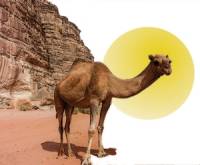
Photos.com
Animals have some amazing adaptations that assist them live in even the most hostile environments. Consider camels, for instance. They can thrive in some of the hottest and driest places on Earth. Their legs don't go burned when they kneel on hot sand due to thick leathery patches on their knees. They can survive for an entire week without water just, at the aforementioned fourth dimension, they tin can drink 32 gallons of water at one time. Their trunk temperature ranges from 93 °F to 107 °F, so they don't demand to sweat very often and tin can conserve h2o this mode. The spongy basic in their noses blot any excess wet to keep every drop of water in, and then the air they exhale out is dry air. In addition to camels, other animals' adaptations are equally remarkable. How do they practice it? Chemistry helps!
Warm-Blooded or Common cold-Blooded?
The most important adaptation is how animals regulate their body temperature. Animals can be either warm-blooded or cold-blooded.
Warm-blooded animals, which are more often than not birds and mammals, need to maintain a relatively constant body temperature or they would suffer dire consequences. Information technology doesn't matter what the outside temperature is—they must maintain the same internal temperature. For us, the commonly accepted average trunk temperature is 98.6 °F (even though it may vary among individuals). Most other mammals range from 97 °F to 103 °F; birds have an average body temperature of 105 °F.
Cold-blooded animals practice not maintain a constant body temperature. They get their heat from the outside environment, so their trunk temperature fluctuates, based on external temperatures. If it is 50 °F outside, their body temperature volition eventually driblet to 50 °F, as well. If it rises to 100 °F, their body temperature will attain 100 °F. Most of the remainder of the animal kingdom—except birds and mammals—are common cold-blooded.
In near instances, the size and shape of an organism dictate whether it will be warm-blooded or cold-blooded. Think about some large animals—elephants, whales, and walruses. Their volume is so big that relying on the outside environs to heat them up would be inefficient and would irksome their response times, putting their survival at take a chance. For that reason, virtually all large animals are warm-blooded.
What about all the birds and mammals that are not large, such as mice and sparrows? The other gene—body shape—comes into play hither. Small warm-blooded animals tend to accept a rounded shape, which ensures that the interior of an organism stays warm the longest time possible. Most cold-blooded organisms have either an elongated or a apartment shape. If you look at a typical fish, their bodies tend to be apartment when viewed head-on from the front. Snakes, lizards, and worms tend to be long and slender. These shapes ensure they can heat upwards and cool downward rapidly.
Within a given species, animals tend to exist larger in colder climates and smaller in warmer climates, an ascertainment known as Bergmann's rule. For example, whitetail deer in the southern office of the United States tend to have a smaller trunk size and less overall mass than whitetail deer in the far northern states.
There are exceptions but, overall, this rule holds truthful, for the following reason: As the volume of an object decreases, the ratio of its surface surface area to its volume increases. In other words, the smaller an creature is, the higher the area-to-volume ratio. These animals lose oestrus relatively quickly and cool downwardly faster, so they are more probable to be found in warmer climates. Larger animals, on the other paw, take lower surface expanse-to-book ratios and lose estrus more slowly, so and they are more probable to exist found in colder climates.
Generating Energy
Warm-blooded animals require a lot of free energy to maintain a constant trunk temperature. Mammals and birds crave much more food and free energy than do cold-blooded animals of the same weight. This is because in warm-blooded animals, the heat they lose is proportional to the surface area of their bodies, while the estrus they produce is proportional to their mass. This means that larger warm-blooded animals tin can generate more than rut than they lose and they can keep their torso temperatures stable more than easily. Smaller warm-blooded animals lose heat more rapidly. And then, information technology is easier to stay warm by being larger. Warm-blooded animals cannot exist too small; otherwise, they volition lose heat faster than they can produce it.
This energy produced past warm-blooded animals mostly comes from food. Food represents stored chemical energy (potential energy), which is converted into other forms of energy within the body when the food is metabolized. Metabolism refers to the all of a body'southward chemical reactions.
The metabolism of food within the trunk is often referred to as internal combustion, since the same byproducts are generated as during a typical combustion reaction—carbon dioxide and water. And like combustion reactions, metabolic reactions tend to exist exothermic, producing heat.
For a warm-blooded animal, food is not simply a luxury—it is a matter of life and death. If food is not bachelor for energy, the torso's fat is burned. In one case fat reserves are used up, decease is imminent if a nutrient source is not found. The smaller the warm-blooded animal, the more it must eat—relative to its body size—to keep its internal furnace stoked. That's why most songbirds fly south for the winter.
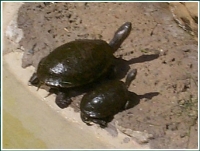
These turtles simply walked out of a pool of cool water.
NASA/JPL-CALTECH
On the other manus, cold-blooded animals crave less energy to survive than warm-blooded animals practice, because much of the energy that drives their metabolism comes from their environs. It is common to see turtles basking in the sun on rocks and logs. They are not trying to get a suntan, but rather are revving upward their metabolism. The lord's day gives them an free energy boost. Musculus activity in cold-blooded animals depends on chemical reactions, which run quickly when it is hot and slowly when it is cold (because the reacting molecules move faster when temperature increases).
Some reptiles, such equally the python, can get a year without eating, considering they do not use food to produce body heat. And if they lie still, they utilise piddling energy, so they can afford to eat little.
Cold-blooded animals take a disadvantage compared to warm-blooded animals: There is a certain temperature beneath which their metabolism only won't work. The reason is that all chemic reactions slow down as the temperature is lowered, then at depression temperatures, all the chemic reactions in an organism ho-hum down.
You lot may observe that few cold-blooded animals are active in the winter, and the farther north you lot go, the rarer they become. By contrast, warm-blooded animals are present in a wider variety of environments and for a longer part of the year than cold-blooded animals.
Hibernation
For warm-blooded animals that don't migrate, one way to survive the winter is to sleep through it. Hibernation is a cracking strategy that enables animals to conserve energy when food is scarce. During hibernation, body temperature drops, breathing and heart rate slows, and most of the body's metabolic functions are put on agree in a state of quasi-suspended animation.
It is almost as if the warm-blooded animal becomes cold-blooded, as its body temperature drops considerably. But they are still alive, and they alive off their fat reserves. Hibernation for extended periods of fourth dimension is but accomplished by those animals that can shop a great deal of body fat, such as bears, groundhogs, and chipmunks. A blackness conduct loses 15%–xxx% of its weight while hibernating.
Common cold-blooded animals hibernate, too. But they need to store less fat than warm-blooded animals because they require less energy. Turtles and frogs bury themselves in mud nether lakes and ponds for up to half-dozen months at a time, and for all applied purposes, they appear dead. At that place are no external signs of life.
When many cold-blooded animals hibernate, something interesting happens at the cellular level. The fluid around the cells, simply not in the cells, is frozen solid. As h2o freezes exterior the prison cell, h2o from within the prison cell is drawn out through osmosis. Osmosis is a procedure in which water moves across a semipermeable membrane—in this case, the cell membrane—from an expanse of low solute concentration to an area of loftier solute concentration.
As water freezes exterior of the cell, the solute concentration increases, because the quantity of liquid water decreases while the amount of solute stays the same. Every bit a result, water flows out of the prison cell to equalize the concentrated solution outside of the prison cell (Fig. 2).
At the same time h2o is leaving the cells, glucose migrates into the cells in copious amounts. By removing h2o and calculation glucose, the concentration of dissolved solute inside the prison cell increases—a lot. The glucose acts as a natural antifreeze, every bit any solute will lower the freezing bespeak of a given solvent—in this case, water. The presence of high concentrations of solutes in the cells allows animals such as frogs to hibernate at temperatures beneath freezing and even so survive. While the h2o around the cells is frozen, the h2o in the cells is not. If water within a jail cell were to freeze, the jail cell membrane would be ruptured, killing the jail cell.

ISTOCK
Keeping Warm
When it is cold outside, you put on more than dress. Your winter coat does non keep out the cold, but rather keeps in the heat. (Cold itself doesn't exist—information technology is merely the absence of heat; see the article titled "Why Common cold Doesn't Exist," on p. 10.) Birds and mammals also rely on insulation to prevent heat loss. The most constructive insulation traps air, since air is one of the best insulators. Wool tends to be warm because its fibers are curled, effectively trapping air and keeping you (and sheep) warm. Birds fluff up their feathers when they want to stay warm, since fluffing introduces air.
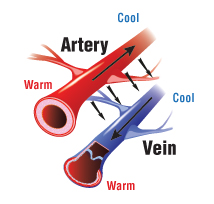
For mammals without hair, insulation is accomplished by blubber, a thick layer of fat tissue which helps to insulate an beast's body because fat does non transfer heat every bit well equally muscle and peel. This blubber may be two feet thick in some whales! Whales, tuna, dolphins, and other warm-blooded marine animals as well rely on some other ingenious method to conserve heat. To preclude excessive heat loss from extremities such equally fins and flippers—which are not well insulated—aquatic animals rely on a "countercurrent heat-exchange method," in which the arteries that carry warm claret away from the heart are positioned directly confronting the veins that conduct absurd blood to the heart. Then, the warmer claret leaving the center through the arteries warms the libation blood entering the heart through the veins.
In contrast to birds and mammals, lizards, frogs, snakes, and other cold-blooded animals do not need insulation—it would merely slow down heat transfer into their bodies.

Shutterstock
Keeping Absurd
When you get hot, what'southward the first affair that happens? Y'all start to sweat. The average adult has 3 million sweat glands. It'south non the sweating that cools you, but rather the evaporation of this sweat. Evaporation is an endothermic phase change, significant it must absorb free energy to occur. This energy is drawn from your body, making y'all libation.
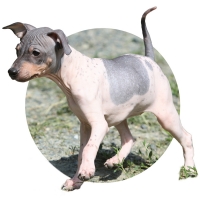
Photos.com
Someday you lose energy, your body will feel cool. Evaporation requires energy because forces of attraction between water molecules—chosen intermolecular forces—need to be broken when h2o goes from a liquid to a gas. In liquid water, the molecules are shut together and are attracted to one another. Evaporation requires free energy because the intermolecular forces of allure between water molecules in the liquid phase must be overcome when water goes from a liquid to a gas. The free energy that goes into overcoming these attractive forces comes from your body.
Do animals sweat? About don't, but some practice. Dogs sweat mainly between the pads on the bottom of their paws. One notable exception is the American hairless terrier, which has sweat glands all over its body, illustrating the fact that fur tends to inhibit sweating because if the sweat can't evaporate it doesn't assistance in the cooling procedure.
Cats not merely have sweat glands on the pads of their anxiety, but also on their tongues! When a cat licks itself, it may not be just to keep clean, just it could also exist to absurd itself as the saliva on their fur evaporates. Kangaroos will lick their forearms for the aforementioned reason.
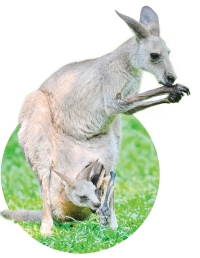
Kangaroos continue absurd by licking their forearms.
Shutterstock
The fundamental to surviving in hot climates is not only to go along your body from overheating but also to forbid water loss. Animals that are adjusted to desert life are non heavy sweaters—because water is scarce, they cannot afford to lose it past sweating. Also, a great deal of water is lost through animate out, then desert animals expel dry out air, reabsorbing the h2o in their jiff earlier it has a chance to be expelled.
The ability of animals to arrange to extreme environments is quite remarkable. Whether information technology is in the freezing corners of Siberia or the sizzling hot desert of the Sahara, animals e'er find ways to survive, and how they exercise information technology will never finish to astonish us!
Brian Rohrig teaches chemistry at Metro Early on Higher High School in Columbus, Ohio. His most recent ChemMatters article, "Not Milk? Living with Lactose Intolerance," appeared in the April 2013 issue.
Source: https://www.acs.org/content/acs/en/education/resources/highschool/chemmatters/past-issues/archive-2013-2014/animal-survival-in-extreme-temperatures.html
Posted by: hinesthestrand.blogspot.com

0 Response to "Which Animal Must Eat More Because It Takes Energy To Maintain A Constant Body Temperature?"
Post a Comment